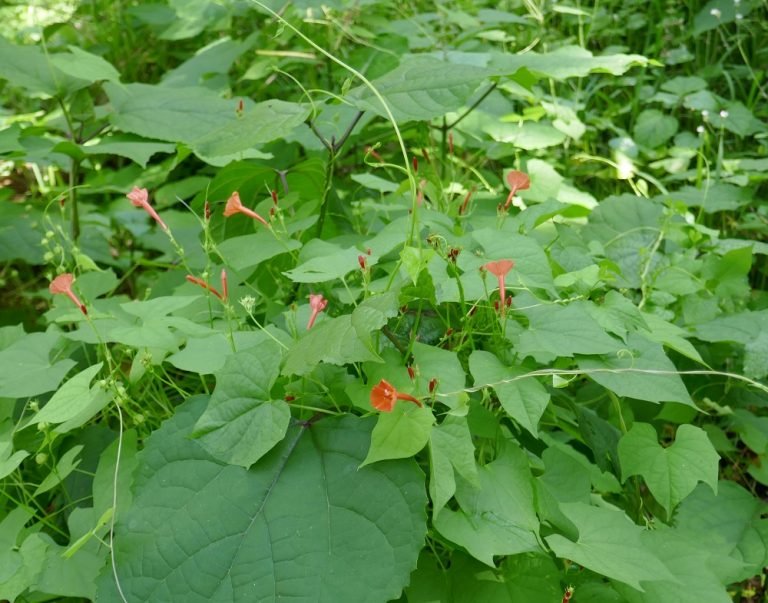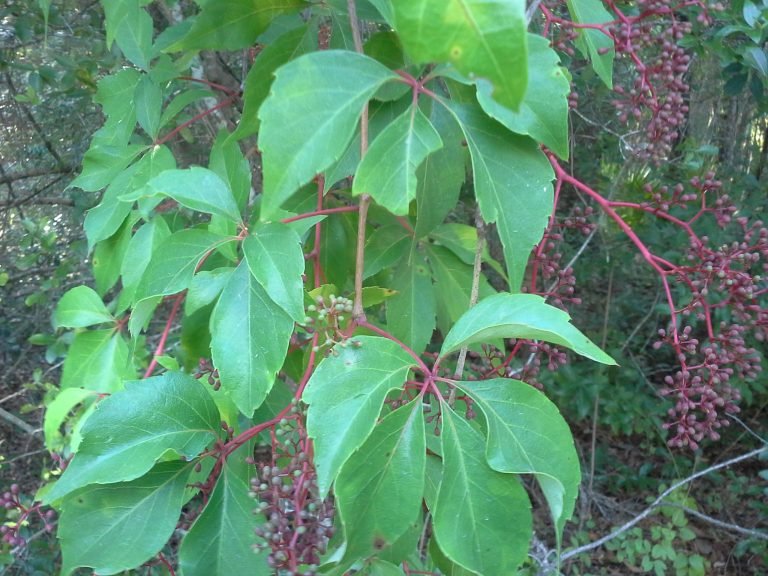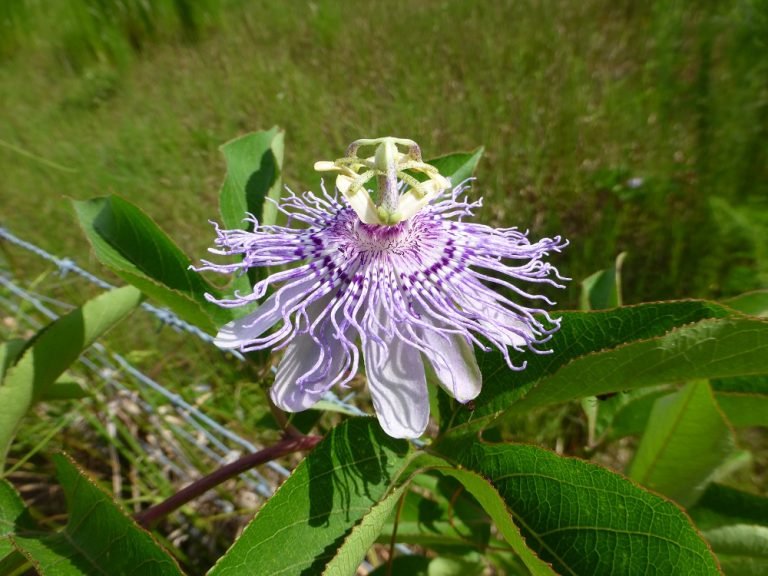Vines Native to Central Florida

Cross Vine (Bignonia capreolata)
Family: Bignoniaceae (Bignonia Family)
Form: Cross vine is a woody, semi-evergreen vine that, at maturity, can reach 50 feet in length.
Leaves: opposite and compound with two leaflets and a tendril in between. The leaf bases may be round or slightly heart shaped and the leaf tip is sharply pointed.
Flowers: large, tubular, flowers in shades of red and orange appear in spring and summer.
Habitat: flooded forests, wet forests, and the margins of each.
Native range: it is native to the following states: AL, AR, FL, GA, IL, IN, KY, LA, MD, MO, MS, NC, OH, OK, SC, TN, TX, VA, and WV.
Landscape use: it grows in part shade with average to moist soils. It flowers best in full sun with regular waterings.
Wildlife use: the flowers are a favorite nectar source for bumblebees and hummingbirds.
Propagation: by transplants and seeds.

Florida Milk Pea (Galactia floridana)
Family: Fabaceae (Bean Family)
Form: Florida milk pea is an herbaceous vine that can reach 3 feet in length. It tends to stay prostrate, and trailing, but will climb up, and over, nearby vegetation, but will not cause any damage.
Leaves: alternate, with three leaflets. The leaflets are oblong to elliptic in shape.
Flowers: small lavender flowers appear throughout the year.
Habitat: pinelands and sandhills.
Native range: it is native to the following states AL, FL, GA, and MS.
Landscape use: in the home landscape it grows in part-shade with average to dry soils. It is a diminutive little vine that can easily get lost in a garden setting.
Wildlife use: small butterflies and bees use the flowers as a nectar source. Songbirds and small mammals eat the flowers, beans, and dried seeds. It is a larval food for the Ceranus blue butterfly.
Propagation: by transplants and seeds.

Carolina Jessamine (Gelsemium sempervirens)
Family: Gelsemiaceae (Gelsemium Family)
Form: Carolina jessamine is a perennial vine that grows to about 30-40 feet.
Leaves: opposite, simple, lanceolate in shape with entire margins.
Flowers: yellow, tubular, with flared petals. Flowers appear in the late winter and early spring.
Habitat: forests, pine flatwoods, disturbed sites and fence rows.
Native Range: it is native to Alabama, Arkansas, Florida, Georgia, Louisiana, Mississippi, North Carolina, South Carolina, Tennessee, Texas and Virginia
Landscape use: in the home landscape it grows in part-shade with average moisture and does well trained on a trellis or mixed in a natural forest setting.
Wildlife use: all parts of this vine contain a toxic alkaloid called gelsemine and the sap can cause skin irritation. The flowers are said to be toxic to honeybees, but not native bees.
Propagation: it transplants easily and can also be grown from seeds.

Scarlet Morning Glory (Ipomoea hederifolia)
Family: Convolvulaceae (Morning-glory Family)
Form: scarlet morning glory is an annual vine that grows to about 20 feet in length. A very well behaved little vine that can be grown along nearby plants without harming them.
Leaves: leaf shape is variable, but most are heart-shaped with three lobes that are pointed at the tips (apices).
Flowers: small tubular in a brilliant shade of red.
Habitat: forests, thickets, and fields.
Native range: it occurs naturally throughout Florida, southern Georgia, west Texas and north to Massachusetts. It also occurs in Mexico and the West Indies.
Landscape use: it grows in part shade to full sun with average moisture.
Wildlife use: the flowers are a nectar source for a variety of pollinators including hummingbirds and butterflies. Songbirds eat the ripe seeds.
Propagation: transplant seedlings or small plants very gently. It readily reseeds where the parent plant was growing the previous season.
I sell these seeds here at my eBay Store.

Coral Honeysuckle (Lonicera sempervirens)
Family: Caprifoliaceae (Honeysuckle Family)
Form: coral honeysuckle is a deciduous vine with woody stems.
Leaves: opposite, simple, obovate with the leaves at the branch ends clasping the stem, margins are entire.
Flowers: red tubular flowers appear in the spring and summer.
Habitat: forests and thickets.
Native range: it is native to the following states: AL, AR, CT, DC, DE, FL, GA, IA, IL, IN, KS, KY, LA, MA, MD, ME, MI, MO, MS, NC, NH, NJ, NY, OH, OK, PA, RI, SC, TN, TX, VA, VT and WV.
Landscape use: it grows in full sun to part shade with average moisture.
Wildlife use: the flowers are a nectar plant for hummingbirds. Some larger butterflies use them. The fruit is eaten by birds.
Propagation: can be transplanted and grown from seeds.

Virginia Creeper (Parthenocissus quinquefolia)
Family: Vitaceae (Grape Family)
Form: Virginia creeper is a native, deciduous, vine that grows to 40 feet.
Leaves: alternate, palmately compound, with three to five leaflets so some people confuse it with poison ivy, margins are doubly toothed.
Flowers: small, reddish in color, and appear in the spring.
Habitat: forests, wet woodlands, disturbed sites, and fence rows.
Native range: it is native to the eastern United States.
Landscape use: in the home landscape it grows in full sun to part shade with average to moist soils. The fall foliage turns a beautiful crimson color. It can become aggressive if not regularly pruned back. Can be a skin irritant.
Wildlife use: the flowers are used by pollinators and the small dark fruit is eaten by a variety of birds and other wildlife.
Propagation: this vine transplants well regardless of the size of the plant and it can also be propagated from seed.

Purple Passionflower (Passiflora incarnata)
Family: Passifloraceae (Passion-flower Family)
Form: purple passionflower is a perennial vine climbing by tendrils, but generally growing prostrate.
Leaves: the leaves are finely toothed, deeply (three – five) lobed, 2 1/2″ wide – 6″ long, with glandular petioles.
Flowers: the large blue-purple banded flowers appear in summer and fall.
Habitat: open fields, pastures, dry forests, and disturbed sites.
Native range: native to the following states: AL, AR, DC, DE, FL, GA, IL, IN, KS, KY, LA, MD, MO, MS, NC, OH, OK, PA, SC, TN, TX, VA, and WV.
Landscape use: in the home landscape it grows in full sun with average moisture. It generally does not stay in its original planting location and will send underground roots to start new plants throughout the area.
Wildlife use: it is a larval food for the gulf fritillary, juliana, and zebra longwing butterflies.
Propagation: is achieved by transplanting rhizomes / roots, seeds and rooting cuttings.

Corkystem Passionflower (Passiflora suberosa)
Family: Passifloraceae (Passion-flower Family)
Form: corkystem passionflower is a perennial vine climbing by tendrils.
Leaves: the leaves are entire to three lobed, 1 1/2″ to 4″ in length. The stems become woody and corky-looking with age.
Flowers: small with long green sepals that resemble petals. In Central Florida it blooms spring, summer and fall.
Habitat: forests and disturbed sites.
Native Range: it is native to Florida and Texas
Landscape use: it grows in part shade with average moisture.
Wildlife use: it is a larval food for the gulf fritillary, juliana, and zebra longwing butterflies.
Propagation: it transplants easily and can be grown from seeds.

Saw Greenbrier (Smilax bona-nox)
Family: Smilacaceae (Greenbrier Family)
Form: saw greenbrier is a semi-evergreen, thorny, vine that grows to 30 feet.
Leaves: alternate, entire, ovate to fiddle shaped. The upper leaf surface is shiny green and the lower is paler. Some leaf bases may be heart shaped.
Flowers: small white flowers appear in the spring.
Habitat: wet forests, wet pinelands, fields, fence rows and thickets.
Native range: found from north Florida south into the Keys, and throughout the entire United States.
Landscape use: plant in part shade to full sun with average to moist soils.
Wildlife use: birds may use the thickets as cover and for nesting. Many animals eat the ripe berries.
Propagation: the tubers transplant very easily, and it is also grown from seed.

Poison Ivy (Toxicodendron radicans)
Family: Anacardiaceae (Cashew Family)
Form: poison ivy is a trailing, deciduous, vine that grows high into treetops and spreads along the ground by hairy rootlets that grow out along the stem.
Leaves: alternate, trifoliate (three), with deeply toothed margins.
Flowers: small white flowers appear in the spring and summer.
Habitat: just about every habitat from dry to wet, roadsides, and fence rows.
Native Range: it is native to the following states: AL, AR, AZ, CT, DC, DE, FL, GA, IA, IL, IN, KS, KY, LA, MA, MD, ME, MI, MN, MO, MS, NC, NE, NH, NJ, NY, OH, OK, PA, RI, SC, SD, TN, TX, VA, VT, WI, and WV.
Landscape Use: it grows in part shade with average to moist soils. Not usually planted because it is poisonous and many people are allergic to the compound urushiol it contains.
Wildlife use: despite its reputation it is a valuable plant for wildlife because of the flower nectar and fruit it provides.
Propagation: this isn’t a vine that people plant on purpose and generally try to eradicate it. I used to let it be, but my husband has a severe reaction to it so I remove it. Herbicides are dangerous so I choose to remove it by hand and shovel.

Muscadine Grape (Vitis rotundifolia)
Family: Vitaceae (Grape Family)
Form: a perennial, woody, vine that grows to over 100 feet in length at maturity.
Leaves: alternate, simple, usually heart-shaped, with toothed margins.
Flowers: small greenish white and appear in the spring and summer. Male and female flowers on separate plants. Only the female produces grapes.
Habitat: forest, fencerows and disturbed sites.
Native range: it is native to the following states: AL, AR, DE, FL, GA, KY, LA, MD, MO, MS, NC, OK, SC, TN, TX, VA, and WV.
Landscape Use: it grows in full sun to part shade with average moisture.
Wildlife use: the flowers are a nectar source for insects and the grapes an important food source for birds and mammals
Propagation: easily transplanted, grown from root cuttings and seeds. Reproducing a fruit bearing female vine should be done from a cutting.

Calusa Grape (Vitis shuttleworthii)
Family: Vitaceae (Grape Family)
Form: calusa grape is a perennial, woody, vine that grows to over 100 feet in length at maturity.
Leaves: alternate, simple to occasionally three lobed, usually heart-shaped, with blunt toothed margins. Lower leaf surfaces have dense, white to rust, colored hairs.
Flowers: small greenish white and appear in the spring and summer. Male and female flowers on separate plants. Only the female produces grapes.
Habitat: forests
Native range: endemic to Florida. Marion County southward to Miami-Dade County.
Landscape use: it grows in full sun to part shade with average moisture.
Wildlife use: the flowers are a nectar source for insects and the grapes an important food source for birds and mammals
Propagation: easily transplanted, grown from root cuttings and seeds. The only assurance of a fruit bearing female vine is from a cutting because there isn’t a way to sex the seeds or seedlings.
You might also like: Milkweeds Native to Florida
